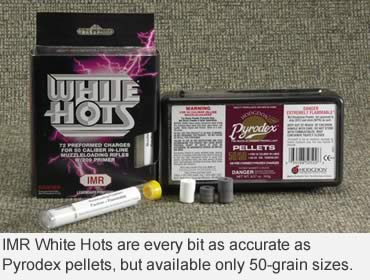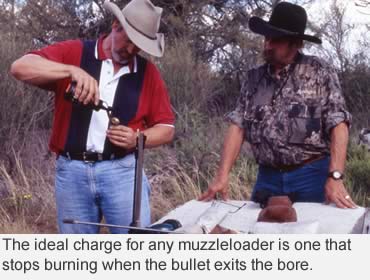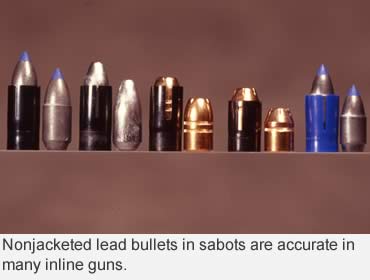By Ralph M. Lermayer
Find the “sweet spot” load, and your modern muzzleloader will begin shooting its tightest groups.
We’ve long been schooled to accept the adage that every centerfire rifle is unique, and you have to try different handloads, bullet weights and brands to find the one your rifle shoots best. This is true. Different barrel twist rates, land dimensions and throating choices, as well as the rifle’s bedding, all have a bearing on accuracy. One would think this same logic would carry over into inline muzzleloaders. To a slight degree, it does, but those effects are minimal in the smokers.
While there are huge differences in inline rifle action styles, stocks, metal quality, finish and hardware — as well as price tags that swing with the options — 95 percent of muzzleloaders carried afield today share one common, vital element. Strip away the external differences, and you’re left with a chunk of steel with a .50-caliber hole through the middle and a 1-in-28 rate of twist in the rifling.
But no matter what the cost, whose label it wears or how it’s ignited, all inline rifles deliver similar results, and all are most accurate with certain loads.
In testing about 40 different inline muzzleloaders over the last 20 years, and keeping detailed records of those tests, I found that those guns’ barrels showed a definite preference for a very narrow load range. In every case, the best accuracy and most efficient burn came within this range, regardless of whose rifle I was testing.
The Power
Choices run from original blackpowder, Pyrodex loose powder or one of the other substitutes like Black Mag, or pellets. Loose powder also brings granulation choices, but FFg is the accepted standard. While they all seem different, they, too, share a similar trait: their rate of burn, or how long it takes the column of propellant to completely burn after it is ignited. That information is vital when searching for the perfect load.
The ideal charge for any muzzleloader is one that stops burning when the bullet exits the bore. Any powder still burning after the bullet is gone is obviously wasted, and it tends to burn poorly, excessively fouling the bore. If the charge stops burning while the bullet is still in the bore, the remaining length of barrel imparts friction and drag. Of course, bullet weight and barrel length have an effect on all this, but we’ll deal with that a bit later.
In a .50-caliber bore with a 24- to 26-inch barrel, the optimum charge runs from 100 grains in the shorter barrel to 120 grains in a 26-incher. With more powder, you may see an increase in velocity, but it comes at the cost of accuracy.
 Bullet Weight
Bullet Weight
The smallest projectile you can shoot from a .50-caliber bore is a round ball. It contacts the bore around its perimeter only. Normally, a cloth patch keeps the lead away from the barrel metal. Typical weight for these is around 190 grains. Make them heavier, and you have to make them longer, creating conicals. With these, lead contacts the bore.
Conicals can run from 200 grains on up to the sky’s the limit. There is a best weight, or optimum range, that delivers the best compromise for velocity, trajectory, powder efficiency, and terminal energy. That falls between 250 and 320 grains. Go lighter, and you sacrifice flight characteristics and energy. Go heavier, and you diminish the range and create brutal recoil. The best of all worlds falls at about 300 grains in a .50 bore. Match a bullet of that weight to the ideal 100- to 120-grain charge, and you’re closing in on any .50-caliber inline’s sweet spot.
Bullet Choice
There are two ways to get to the magic 300-grain conical or saboted bullet. Conicals can be Power Belts, or pure lead. Saboted choices include a wide range of sub-caliber (usually .45), bullets housed in a polymer sabot. Any of them will produce the desired results. Each has pros and cons.
Pure lead conicals are devastating on game, but can’t be driven very fast or they will lead up a bore.
Power Belts keep the bore clean and can be driven to near max speeds, but since they are full bore size, they give up a bit in trajectory. Because they tend to be the smallest diameter of all the conical choices, they are a good bet for an overly tight bore.
Saboted bullets add yet another component, but they keep the bore clean, deliver the flattest trajectory and are accurate in a wide variety of rifles. They often deliver groups of an inch or less from quality barrels when matched to the correct charge.
Whichever bullet you choose, stay within that narrow weight range. I personally shoot nonjacketed pure lead bullets in sabots. Using 295- to 320-grain pure lead bullet over 120 grains of powder in my 26-inch rifle, I’ve taken game from antelope to elk at ranges from 5 to 250 yards. It is the only bullet I shoot. You will find identical results in any inline out there.
 Powder or Pellets?
Powder or Pellets?
The propellant form makes no difference. One-hundred to 120 grains of loose blackpowder, blackpowder substitute, Pyrodex or pellets will give you the same results. Pellets do bring an advantage that can’t be ignored, but it has nothing to do with convenience!
If you vary the seating pressure on loose powder — how hard you push down on the ramrod when loading -- pressure is altered. The impact on a target from a tight pack can be substantially different from a loose column’s. Competitive blackpowder shooters have known this for centuries. They take great pains to ensure loading pressure is consistent from shot to shot.
Pellets remove that variable. Drop them down the bore, seat the bullet on top, and shoo - you get the same result every time. My choice? Pellets, always! They’re available in 30- and 50-grain sizes so you can go from 100 to 120 grains by simply stacking them.
When Pyrodex pellets were first introduced, they were available only in 50 grain sizes. If you wanted a charge exceeding 100 grains, you had to go to 150. You had no choice, and that gave birth to the 150-grain load fad. Hodgdon knows muzzleloading, recognized that charge was inefficient, and introduced the 30-grain pellets to get us back to ideal.
When a new rifle comes in for testing, I know exactly what to feed it without a whole lot of load workup.
If it has a 20-inch barrel, it gets 100 grains of Pyrodex Triple 7 pellets and a 250- to 275-grain PowerBelt or Buffalo SSB. If it has a 24-inch tube, it gets the same bullet choice over 110 grains of powder. Best choice for a 26-inch-barreled rifle is a 300- or 325-grain bullet over 120 grains of pellets.
 Off the Norm
Off the Norm
These aren’t the only loads that will perform well in your inline. I know several shooters who regularly go to the limit with a 250-grain bullet over a full 150-grain charge. Another hardcore elk hunter shoots a 435-grain Buffalo Bullet over 150 grains of powder in his custom 28-inch-barreled muzzleloader. You can make other loads work, but in the case of the above-mentioned variations, it usually comes with a trade-off. The loads recommended here are just the most efficient ones and will serve well in most muzzleloading hunting situations.
If the rifle’s any good, it will punch the kind of 100-yard groups you like to cut out and carry in your wallet. If it won’t shoot these loads, it has mechanical problems no amount of load workup and tinkering will fix.
Save your time and powder, and stick with what works.
This article was published in the July 2009 edition of Buckmasters GunHunter Magazine. Subscribe today to have GunHunter delivered to your home.